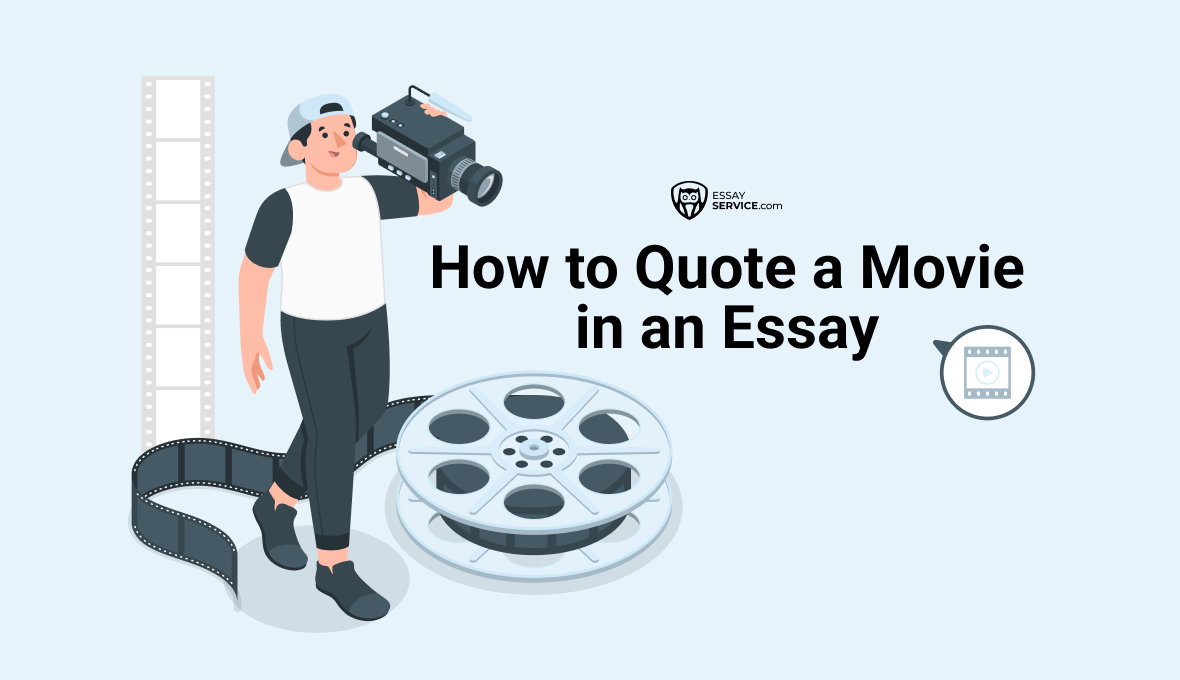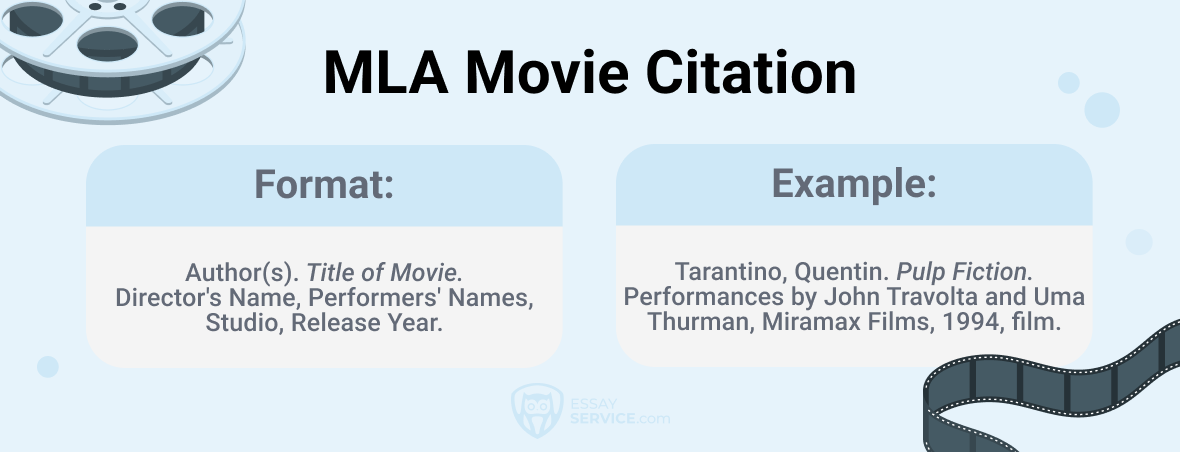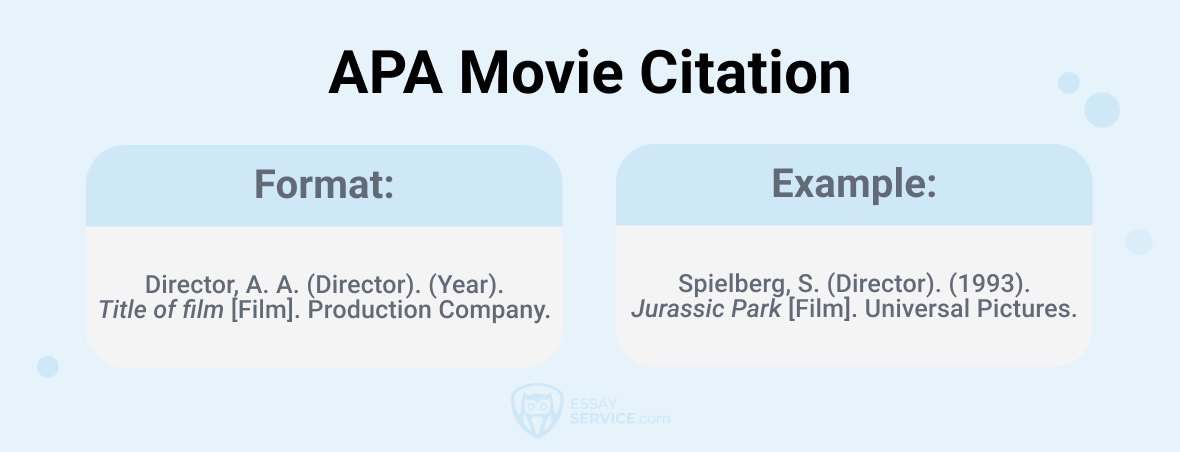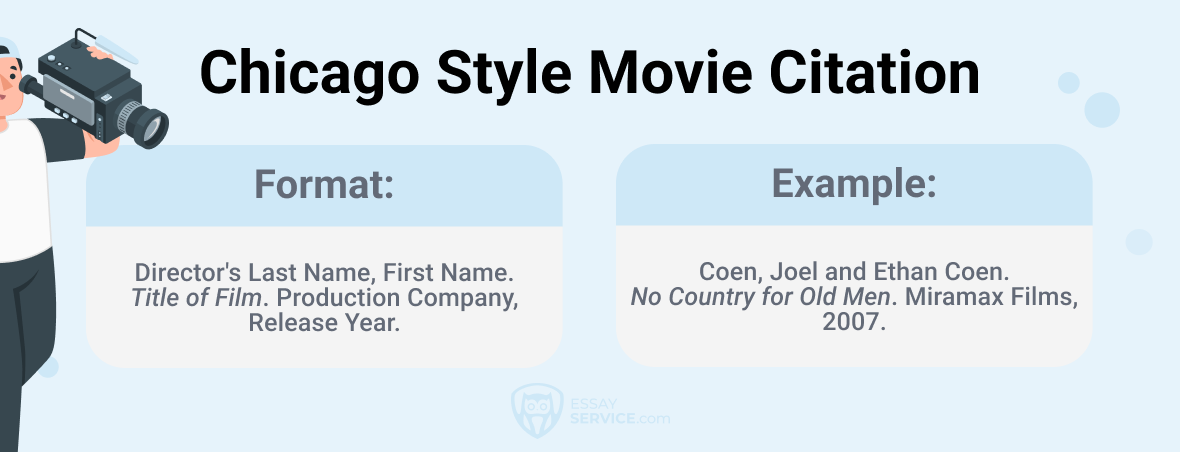
How to Quote a Movie in an Essay in Different Styles?
Movies are more than just entertainment—they're also valuable resources for academic writing. Quoting movies in essays can bring your arguments to life and make them more relatable to your readers. Whether you're emphasizing a point, establishing authority, or enhancing clarity, a well-placed movie quote can pack a punch that paraphrasing or summarizing simply can't match.
In today's educational landscape, where courses often integrate audiovisual materials, knowing how to quote a movie is becoming increasingly important. Whether you're studying Arts, Engineering, Programming, Sound Recording, or 3D Design, you'll likely encounter situations where citing films is necessary.
But it's not just about throwing in a quote here and there. Improper citing can land you in plagiarism trouble, especially when dealing with audiovisual sources. That's why understanding the proper methods for putting a quote in an essay is crucial.
This guide will walk you through the ins and outs of how to cite movie quotes, covering everything from formatting requirements to citation styles. By following these guidelines, you'll not only enhance the credibility and engagement of your work but also ensure it meets the standards of academic writing.
Types of Citations
Citing different types of quotes in an essay correctly requires sticking to the right instructions. These instructions usually come from formatting guidelines found in popular styling guides such as APA, MLA, and the Chicago Manual of Style. Sometimes, Turabian styling is also used, which is quite similar to the Chicago manual.
In practice, you'll use two main types of citations: in-text citations and a bibliography. In text citation for a movie points directly to your quote within the text and guides readers to the full source listed in your bibliography. Making mistakes in one can throw off the accuracy of the other, so it's crucial to get both right.
You don't have to become an expert in every styling guide out there, though. Whether it's an APA citation for movie or MLA, you'll just need to know the specific rules of the one your professor or publisher asks for.
Now, understanding how to cite a movie quote MLA or APA style can be a bit challenging. Academic writing formats can vary, and when it comes to citing online sources like YouTube or physical media such as CDs, things can get even trickier. Universities usually prefer APA, MLA, or Chicago academic formats, each with its own unique features. But don't worry, that's where we come in—to guide you through the specifics of each style when it comes to knowing how to quote a film.
Audiovisual Citations
Though written sources are more common in academic research, using audiovisual content is getting more popular, especially in areas like media studies, communication, and film analysis. It's important to know how to cite these materials correctly to maintain academic honesty and give credit to creators. Audiovisual citations cover a wide range of materials like:
- movies
- documentaries
- TV shows
- podcasts
- online videos
When citing audiovisual sources, you need to think about the format of the material and how accessible it is, as well as its role in your research. For example, citing movie quotes might be different from citing a YouTube video or a podcast episode. You might need to include details like the director, producer, actors, release date, and even the specific part you're referencing.
By giving detailed citations for audiovisual content, researchers make it easier to check sources and keep academic standards high in a world where multimedia is increasingly important. Below are some examples of how to quote a film, along with other audiovisual sources.
MLA Movie Citation
Knowing how to cite a movie MLA 8 follows a specific format to ensure clarity and consistency in academic writing. When citing a movie in your bibliography or works cited page, you need to include key information such as the title, director, performers, studio, release year, and format. Ensure the name of the movie is italicized, and list performers after the director's name.

Format: Author(s). Title of Movie. Director's Name, Performers' Names, Studio, Release Year.
For specific examples of how to quote movies and different audiovisuals, keep on reading!
Audio Recording
Citing audio recordings, such as podcasts or music albums, in MLA style requires attention to detail to accurately credit the creators. In addition to the title and creator(s), you also need to include information about the medium (e.g., podcast episode, song) and any relevant contributors (e.g., guest speakers, featured artists).
Format: Author(s)/Performer(s). Title of Recording. Publisher, Publication Date.
Example 1: Podcast Episode Gladwell, Malcolm. "The Lady Vanishes." Revisionist History, Slate, 2016.
In this example:
- Gladwell, Malcolm is the creator of the podcast episode.
- The Lady Vanishes is the title of the podcast episode.
- Slate is the publisher.
- 2016 is the publication date of the episode.
If you want to include an in text citation example MLA, you might write something like: Gladwell discusses the mysterious disappearance in his podcast episode "The Lady Vanishes" (Gladwell).
Example 2: Music Album Swift, Taylor. Folklore. Republic Records, 2020.
In this example:
- Swift, Taylor is the performer and likely the main creator of the music album.
- Folklore is the title of the music album.
- Republic Records is the publisher.
- 2020 is the publication date of the album.
Below, let's find out how to cite a movie quote in MLA!
Film/Motion Picture
When citing a film or motion picture in MLA style, it's important to include essential details such as the director, performers, studio, release year, and format. This ensures that readers can easily locate the referenced material and understand its context within your research.
Format: Director(s). Title of Film. Performers' Names, Studio, Release Year, Format.
Example: Tarantino, Quentin. Pulp Fiction. Performances by John Travolta and Uma Thurman, Miramax Films, 1994, film.
In this example:
- Tarantino, Quentin is the director of the film.
- Pulp Fiction is the name of the film.
- John Travolta and Uma Thurman are performers in the film.
- Miramax Films is the studio that produced the film.
- 1994 is the release year of the film.
Now, if you want to know how to quote a movie in MLA, follow these guidelines:
- If you're quoting dialogue from a movie, include the character's name and the timestamp of the scene in the format (Director's Last Name timestamp). For example, (Tarantino 01:23:45).
- Ensure that the quote is faithfully reproduced from the movie and enclose it in double quotation marks.
- Provide the specific details of the scene to help readers locate the quote within the movie.
- Remember to include the movie title in italics and the director's last name in parentheses in your in-text citation.
For instance, if you were quoting a memorable line from "Pulp Fiction" directed by Quentin Tarantino, your in-text citation would look like this:
"The path of the righteous man is beset on all sides by the inequities of the selfish and the tyranny of evil men" (Tarantino 00:42:17).
Radio Broadcast
Moving on from the MLA in text citation movie quote, citing a radio broadcast in MLA style also requires attention to detail to provide context for the material being referenced. In addition to the title and creator(s), you should include information about the program title, broadcast date, and any relevant contributors (e.g., guest speakers, hosts).
Format: Author(s)/Host(s). "Title of Broadcast." Title of Program, Radio Station, Broadcast Date.
Example: Smith, Emma, and James Johnson. "Breaking News Update." Morning Edition, NPR, 10 May 2023.
In the example above:
- Smith, Emma, and James Johnson are the hosts or reporters of the broadcast.
- Breaking News Update is the name of the radio broadcast.
- Morning Edition is the name of the program.
- NPR is the radio station that broadcasted the program.
- 10 May 2023 is the broadcast date.

APA Movie Citation
Citing a movie in APA style involves providing detailed information about the film to help readers locate it. Key elements include the director, producer, release year, and studio. The format for citing a movie in APA style is as follows:

Format: Director, A. A. (Director). (Year). Title of movie [Film]. Production Company.
Now, if you want to know how to in text cite a documentary, here's how to do it:
- Identify the director(s) and the year of release of the documentary.
- Use the last name of the director(s) and the year of release within parentheses.
- If the director(s) is mentioned in the sentence, only include the year of release in parentheses.
Example 1: The documentary "13th" explores the intersection of race, justice, and mass incarceration (DuVernay, 2016).
Example 2: According to DuVernay (2016), in her documentary "13th," the history of racial inequality in the United States can be traced through the criminal justice system.
If you're also curious about how to quote films in an essay using APA style, here's the steps to take:
- Include the name of the film and the timestamp of the scene.
- Enclose the quote in double quotation marks to indicate direct speech from the film.
- Specify the source of the quote in parentheses after the quote itself.
For example:
- "I'll be back" (Cameron, 1984, 01:23:45).
This quote is from the movie "The Terminator," directed by James Cameron, released in 1984, and occurs at the timestamp 01:23:45.
Audio Recording
When citing an audio recording in APA style, such as a podcast episode or a music track, include details like the author or performer, the name of the recording, the year it was published or aired, and the medium. Here's the format for citing an audio recording in APA style:
Format: Author/Performer. (Year). Title of recording [Medium]. Publisher.
Example: Brown, S. (Host). (2022). Exploring Space [Podcast episode]. ABC Podcasts.
In this example:
- Brown, S. is the host of the podcast episode.
- Exploring Space is the name of the podcast episode.
- 2022 is the year the podcast episode was published.
- ABC Podcasts is the publisher.
Ensure the name of the recording is italicized, and specify the medium in square brackets after the title.
Film/Motion Picture
As we mentioned above, when using APA style for citing movies, you should include the director, producer, release year, and studio. Here's the format for citing a film or motion picture in APA style:
Format: Director, A. A. (Director). (Year). Title of film [Film]. Production Company.
Example: Spielberg, S. (Director). (1993). Jurassic Park [Film]. Universal Pictures.
In this example:
- Spielberg, S. is the director of the film.
- Jurassic Park is the name of the film.
- 1993 is the year the film was released.
- Universal Pictures is the production company.
Ensure the title of the film is italicized, and list the director's name with their initials followed by "(Director)" in parentheses. Also, specify the format as "[Film]" after the name of the movie.
As you're reading this article, take a moment to explore our exclusive guide on how to write a movie title in an essay. We've got you covered with all the essential details!
Radio Broadcast
Citing a radio broadcast in APA style requires providing details such as the author or host, the title of the broadcast, the year it aired, and the medium.
Format: Author/Host. (Year). Title of broadcast [Radio broadcast]. Radio Station.
Example: Johnson, E., & Brown, J. (2024). Breaking News Update [Radio broadcast]. NPR.
In this example:
- Johnson, E., & Brown, J. are the hosts of the radio broadcast.
- Breaking News Update is the name of the broadcast.
- 2024 is the year the broadcast aired.
- NPR is the radio station.
Chicago Style Movie Citation
In Chicago style, citing a movie requires providing detailed information about the director, name, release year, and studio to ensure accurate referencing. Here's the format for citing a movie in Chicago style:

Format: Director's Last Name, First Name. Title of Movie. Production Company, Release Year.
Now, let's find out how to cite a quote from a movie Chicago style:
- Include the name of the movie and the timestamp of the scene.
- Enclose the quote in double quotation marks to indicate direct speech from the movie.
- Specify the source of the quote in parentheses after the quote itself.
For example:
- "Here's looking at you, kid" (Curtiz 1942).
This quote is from the movie "Casablanca," directed by Michael Curtiz and released in 1942.
Audio Recording
When citing an audio recording, such as a podcast episode or music track, in Chicago style you should provide essential details like the creator, title, publication year, and format.
Format: Creator's Last Name, First Name. Title of Recording. Year of Publication.
Example: Gladwell, Malcolm. Revisionist History: The King of Tears. 2016.
In this example:
- Gladwell, Malcolm is the creator of the recording.
- Revisionist History: The King of Tears is the title of the recording.
- 2016 is the year of publication.
Film/Motion Picture
Here's the detailed example for citing a film in Chicago style:
Format: Director's Last Name, First Name. Title of Film. Production Company, Release Year.
Example: Coen, Joel and Ethan Coen. No Country for Old Men. Miramax Films, 2007.
In this example:
- Coen, Joel and Ethan Coen are the directors of the film.
- No Country for Old Men is the name of the film.
- Miramax Films is the production company.
- 2007 is the release year of the film.
Radio Broadcast
Now, if you're citing a radio broadcast in Chicago style, make sure to include details such as the author or host, name of the broadcast, publication year, and medium. Ensure the title of the broadcast is italicized, and list the author or host's name in natural order (last name, first name).
Format: Author/Host. Title of Broadcast. Year. Medium.
Example: Smith, Terry Gross. Fresh Air. 2019. Radio.
In this example:
- Smith, Terry Gross is the host of the broadcast.
- Fresh Air is the name of the broadcast.
- 2019 is the publication year.
- Radio specifies the medium.
5 Useful Movie Citation Tips to Consider
By now, you've probably got the hang of how to cite a quote from a movie or any other audiovisual sources. But beyond just knowing how to format things, here are some tips our experts want to share:
- Give Background: When citing a movie, think about adding a bit of context in your paper. Explain why you're referencing the movie and how it fits into your argument or research.
- Show Original Source: If the movie is based on a book or another source, acknowledge it in your citation. This helps readers understand the connection between the movie and its original material.
- Talk About the Director: Sometimes, the director's vision or style can be crucial to your discussion. If it's relevant, mention the director's influence in your citation or paper.
- Highlight Great Acting: If there are standout performances in the movie that relate to your analysis, talk about them. It adds depth to your discussion and understanding of the movie's impact.
- Handle Tough Topics Carefully: If the movie tackles sensitive subjects, handle them thoughtfully. Provide warnings if needed and approach the material with sensitivity and respect for your readers.
Last Words
When you're citing a movie in your academic writing, it's important to get the details right. Forgetting key information like the director's name or release year can make your citation incomplete. So, as you start referencing movies in your essays, remember to include all the necessary details to make your citation accurate and useful for your readers. We hope our guide has given you a confidence boost, and if you ever need a hand with other academic tasks, such as using a movie review writing service, we're here to help!
Frequently asked questions
How to Cite a Quote from a Movie?
When citing a quote from a movie, include the name of the movie, the director's name, the year it was released, and the timestamp of the quote, if applicable.
For example: 'Title of the Movie' (Director's Name, Year), timestamp.
(The Shawshank Redemption, directed by Frank Darabont, 1994) 'Get busy living, or get busy dying.' (0:54:32)
How to Quote Dialogue from a Movie in an Essay?
To quote dialogue from a movie in an essay, use double quotation marks around the spoken words. Include the character's name, if known, followed by the spoken words.
For example: 'Character's Name: Spoken words.'
(Forrest Gump, directed by Robert Zemeckis, 1994) Forrest Gump: "My mama always said, 'Life was like a box of chocolates. You never know what you're gonna get.'" (0:09:17 - 0:09:28)
How to Quote a Character in a Movie?
To quote a character in a movie, use the character's name followed by the spoken words enclosed in double quotation marks. If the character's name is not known, describe them briefly.
For example: 'Character's Name: Spoken words' or 'Description of Character: Spoken words.'
(Star Wars: A New Hope, directed by George Lucas, 1977) Princess Leia: "Help me, Obi-Wan Kenobi. You're my only hope." (0:19:43)
- added new sections;
- added FAQs.
- Research guides: APA citation style guide (7th edition): Audiovisual media. Audiovisual Media - APA Citation Style Guide (7th Edition) - Research Guides at Thompson Rivers University Library. (n.d.). https://libguides.tru.ca/apa/audiovisual
New posts to your inbox!
Your submission has been received!



.webp)